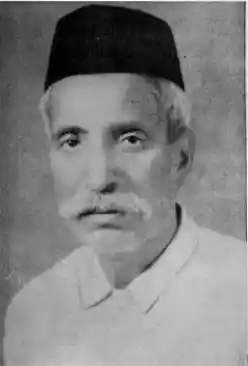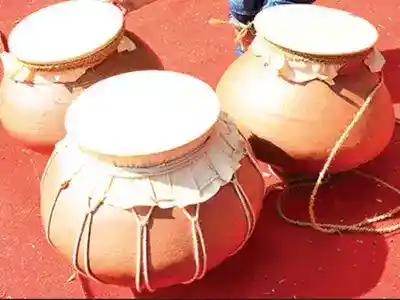Musician? Mathematician? Magician?
An instrumentalist and musician who wove his taala and laya in mathematical accuracy. Those who witnessed him perform, report it as nothing short of magic. We are unsure of what to call him, a musician? mathematician? or a magician?

The Shining Sun of Rhythm; Image Source: Rajan Parrikar Music Archive
Laxmanrao alias Khaprumam Parvatkar was born in the vibrant state of Goa where he also spent most of his life. He hailed from the village Parvati which is famous for producing some notable names in the musical history of India including Dulubai Parvatkar, Mogubai Kurdikar, Harishchandra Parvatkar, Shaambha Parvatkar, Raghuvir Parvatkar, Baalkrishna Parvatkar, and Dattaramji Parvatkar.
Khaprumam was a musician and instrumentalist who played the sarangi, pakhawaj, and ghumot (a traditional percussion instrument made using an earthen vessel and monitor lizard leather), but what set him apart? His ardent passion and his undying love for the beats.
Even as a kid, he would continuously practice the taala, maatras, and avartans on his fingers until he was satisfied.
For the uninitiated, a taala or laya is a set of certain maatras or beats, which **may be seen analogous to arithmetical calculations where the sam or first beat of a taal denotes the completion of one sequence (avartan), and getting it right is similar to proving a mathematical theorem. How elaborate or creative one wants their calculations or layakaari to be is up to them.
Rajan Parrikar, a preserver of musical archives compares it to the 'realm of pure mathematics, Number Theory in particular, where the statement of propositions is facile but their solution lies outside the ken of all but the most gifted mathematicians'.
Not only did Khaprumam master the taala and laya but would often level up and consistently experiment to challenge himself. He would play with the beats, sometimes speeding up or slowing them down, working them out at a particular tempo, adding half or a quarter beat in some place, subtracting, multiplying, or dividing the beats, but almost never missing the sam.
The rhythm of his life revolved around the beats of his Tabla and ghumot. Like a saadhu, Khaprumam was deeply devoted to his music. His day was absorbed in his music and he became oblivious to sensations of thirst and hunger. His mind was constantly concocting new taalas or different ways of playing them out and when he would come up with a brilliant idea, he would not care where he was or what he was doing. His contemporaries often tell stories of how like Archimedes, Khaprumam would have his Eureka moments and in the middle of a bath, would come and note down his newest discovery.
Anyone who’s acquainted with Indian classical music or dance would know the amount of practice that is required to master the rhythm of a taala. The taali or khaali, if missed even by a microsecond, can ruin the entire sequence. What we are going to tell you next about this percussionist legend is not for the faint-hearted.
Thoroughly immersed into laya and taala, Khaprumam would astound his audience with an uncanny ability to simultaneously play out 4 to 5 taalas using his hands, legs, and voice, sometimes interchanging the bols of one with the taala of another.
One of his many ethereal performances had him play the Teen Taal and Jhaptaal with each leg, Roopak, and Ektaal with each hand, while reciting the Pancham Sawari.
Sometimes he would play a paran on the tabla while reciting the same paran in reverse and synchronously bringing them to the sam. Such a display would have been capable of putting anyone in a dizz.
Once at a private concert, he started counting out on his hand the 12 beats of chautal, and simultaneously proceeded to recite the bols of dhamar (14 beats). Gradually, he replaced the standard rhythm of dhamar with the improvised bols (padhant), of dhamar. Rhythmically, the clapping and recitation of bols were completely unrelated but both were true to their respective taalas and the two-time cycles accurately terminated on their exact sams. To achieve a feat of this stature is incomparable, he was truly gifted.
He is also credited with the composition of the ParaBrahma taala which has 15.75 beats and was truly a one-of-a-kind creation. The maestro did not stop there. He created a Maha Sudarshan Paran in this taala, an extremely difficult tabla composition that had a whopping 125 dha’s. This made him famous across the country.
For his exceptional talent and entrancing performances, he was crowned as “Lay Bhaskar” (Brilliant in laya or rhythm), as the “Auliya of laya” (Prophet of laya), and as “The Shining Sun of Laya.” He was also presented with the title “Tala Kantha Mani” (The glittering jewel in the crown of tala). One of his disciples, Mogubai Kurdikar, had a statue made for her Guru. His love for music has been immortalised through the “Lay Bhaskar Khaprumam Parvatkar Taal Mahotsav '' organized by the Kala Academy, Goa.
It is pitiful that the legends of this great artist have not been transmitted through generations due to a lack of documentation and records. This great soul passed away on September 3rd, 1953, becoming one with the rhythm of the universe. In commemoration of his great accomplishments, this is a humble tribute from us to Khapru Ji, for any combination of words may not be able to do justice to his sagacious love for layakaari.

A popular folk instrument of Goa, Ghumot; Image Source: Times of India


